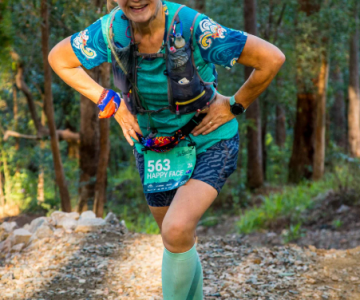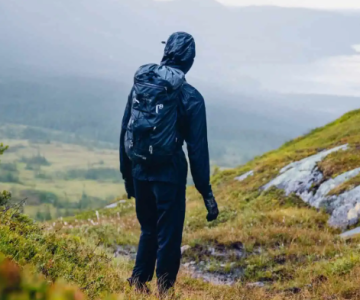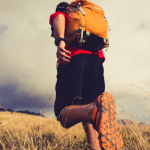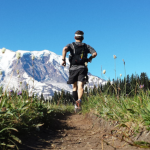Fastpacking is the perfect blend of trail running and ultralight backpacking, offering a way to go further and faster in the wilderness with minimal gear. This dynamic approach allows you to cover more ground than traditional hiking, pushing you to the limits of your endurance while keeping your pack light. If you’re a trail runner eager to expand your range and explore more remote areas, fastpacking could be the next adventure for you. Here’s an introduction to get you started.
What is Fastpacking?
At its core, fastpacking combines trail running with ultralight backpacking. The idea is simple: run with a light pack and a minimalist kit, allowing you to attempt multi-day trips that would normally require a full backpacking setup. Unlike ultralight backpacking, fastpacking emphasizes speed, which significantly impacts the type of gear you use. Fastpackers use running-specific shoes and wear gear designed for efficiency, ensuring their packs minimize bounce and stay snug as they move.
Why Fastpacking?
Fastpacking appeals to adventurers who crave the freedom of running while also wanting to extend their journey beyond a single day. It allows you to access more remote locations, often reaching places that hikers might take days to explore. The best part? You can cover more terrain in less time, which means you can explore more over a weekend than you would with traditional backpacking. Ultimately, fastpacking is about pushing yourself to go faster, further, and lighter while embracing the challenge of minimalist packing.
Key Challenges
The primary challenge in fastpacking is managing pack weight. Most fastpackers aim for a base weight of under 5 kg (11 lb), with the total pack weight—including food and water—capped at 9 kg (20 lb). This requires careful planning to make sure you have everything you need without carrying unnecessary extras. It means researching ultralight gear and packing high-calorie, lightweight food that fuels you without weighing you down.
Planning Your Fastpacking Trip
Choosing the Right Trail
For your first few fastpacking adventures, it’s important to choose routes that are within your ability. Pick trails that match the distance of a moderate training run, as carrying a pack—regardless of how light it is—will slow you down. Make sure to consider trail exit points and potential escape routes in case something goes wrong. Avoid routes that take you too deep into the backcountry without proper preparation.
Water Sources
One of the advantages of fastpacking is the ability to carry less water by refilling along the way. Researching water sources is essential. Look at topographic maps for rivers, streams, or lakes, and check in with rangers to ensure these water sources are reliable and accessible. Knowing where to find water lets you make more informed decisions on how much water to carry and whether to bring a water filter or purifier.
Ideal Conditions
Fastpacking is best suited for mild conditions. For safety and comfort, plan your trips for late spring, summer, or early fall, depending on your location. These seasons provide the most predictable weather, which makes your lightweight gear more effective. Avoid cold-weather fastpacking until you’ve gained enough experience in both fair-weather running and cold-weather hiking.
Check the Weather and Trail Conditions
Before you set out, always check the weather forecast. Since you’ll be relying on minimal gear, knowing what conditions to expect can help you adjust your packing. Be prepared for sudden changes in weather, especially in mountainous areas, where storms can develop quickly. Checking local weather patterns and trail conditions will help you avoid unpleasant surprises.
Share Your Itinerary
Even if you’re fastpacking with a partner, always share your itinerary with someone you trust. This includes telling them your planned route, expected return time, and any contingency plans for emergency situations. This step is essential for your safety in case anything goes wrong.
Apply for Permits
Certain backcountry areas require permits, so make sure to research the area and secure any necessary permissions. Also, familiarize yourself with regulations regarding waste disposal—some areas require you to pack out human waste, while others encourage packing out toilet paper. For tips on how to manage waste in the backcountry, check out my article on wilderness hygiene.
Packing for Fastpacking
Create a Packing Checklist
In fastpacking, every gram counts. Start by creating a packing list and focus on the essentials. Remember that if you’re traveling with a partner, sharing gear is a great way to reduce weight. For example, you don’t need separate stoves, shelters, or first aid kits—one of each will suffice. Group gear also makes your pack lighter and more manageable.
Meal Prep and Cooking
When fastpacking, you’ll need about 3,000 to 4,000 calories per day depending on the terrain and your metabolism. To minimize weight, focus on high-calorie, low-weight foods like freeze-dried meals, bars, and snacks. If you bring a stove, you can rehydrate meals and cook simple dishes like rice or oatmeal. If you decide to skip the stove, you’ll need to rely on lightweight trail snacks like trail mix, cheese, and nut butter.
Stove or No Stove?
The decision to bring a stove depends on your preference. Packing a stove allows you to make hot meals, which can be a real comfort in cold weather. However, stoves also add weight, and if you’re fastpacking in warm conditions, you may decide to forgo the stove entirely. If you do pack one, choose a lightweight option like an alcohol stove or compact canister stove.
Essential Fastpacking Gear
The Right Pack
The right pack is critical to your comfort. Choose a pack between 25 to 30 liters, ensuring it fits snugly to reduce bouncing. Avoid packs with an internal frame, as these can be bulky. Look for packs with easily accessible pockets for water bottles and small items like a phone or GPS. Features like a rain cover and trekking pole attachments can also be valuable.
Trekking Poles
Whether or not to use trekking poles depends on your personal preference. Poles help with balance, especially on downhill sections, and can also aid in setting up a tarp or shelter. If you choose poles, go for lightweight, adjustable models that can be folded up when not in use.
Hydration System
On fastpacking trips, you’ll want a hydration system that’s easy to use and doesn’t weigh you down. A water reservoir allows for hands-free drinking, while bottles (either hard or soft) are easier to refill. Consider how your system will fit into your pack and how easily you can access it while running.
Navigation Tools
A GPS can be invaluable for tracking your route, but it’s important not to rely solely on technology. Always carry a map and compass as backup. Also, consider a satellite messenger for safety, especially on longer or more remote trips.
Shelter Options
Depending on the weather and your comfort level, you may choose a tent, shelter, or tarp. Tents offer the most protection but tend to be heavier, while tarps are lighter but less protective. If you’re aiming to keep your weight under 5 kg, opt for a lightweight shelter or tarp and share it with a partner to minimize weight.
Sleep Setup
Choose a sleeping pad and quilt that balance weight and comfort. Closed-cell foam pads are light but bulky, while air pads are more compact and provide better insulation. If you use a quilt, make sure your pad has a high enough R-value to keep you warm at night.
Getting Started with Fastpacking
To succeed in fastpacking, start by building your fitness and gaining experience with both trail running and light backpacking. Test your gear on local trails before venturing into more remote areas. Adjust your kit and technique as you go, and partner with more experienced fastpackers to learn the ropes. Most importantly, practice Leave No Trace principles to preserve the wilderness for future adventurers.





